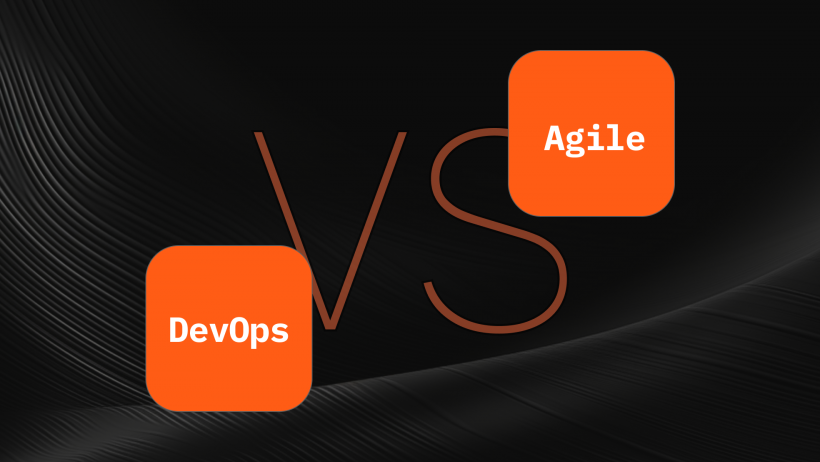If you work in software development, chances are you’ve heard both terms — Agile and DevOps — tossed around in meetings, presentations, or job descriptions. You might have even heard them used interchangeably.
In 2025, this confusion still happens surprisingly often. A project manager might say, “We work Agile,” but what they actually mean is that the team has a CI/CD pipeline and automated deployments, which is more in the DevOps camp.
So, what’s the real difference between DevOps vs Agile? And how do you decide which approach is right for your project? In this article, we’ll break it down in plain language, compare the two, show how they can work together, and give you real-world scenarios so you can make the best call for your team.
Common confusion between DevOps and Agile
Agile and DevOps are both about speed, collaboration, and quality, but they approach these goals from different directions.
Agile focuses on the planning, development, and iterative improvement of software. It’s about organizing work into manageable cycles, engaging stakeholders early and often, and adapting quickly to changing requirements. Agile thrives in an environment where flexibility and customer feedback are central to success.
DevOps, on the other hand, takes over once code is ready to move beyond the developer’s laptop. It focuses on building, deploying, and operating that software in real-world conditions. DevOps brings in automation, monitoring, and streamlined workflows to ensure that features don’t just get built quickly, they get delivered to users reliably and repeatedly.
Because both aim to shorten delivery cycles, reduce bottlenecks, and improve end results, it’s easy to see why the two are sometimes mistaken for the same thing. But in reality, they are complementary, not identical. Agile is about creating value, while DevOps is about delivering and sustaining that value.
Why the distinction matters in 2025
As software development grows more complex and teams become increasingly distributed, the difference between devops and agile can easily blur. In a world where speed, quality, and seamless collaboration are must-haves, knowing exactly how DevOps and Agile differ is a game-changer.
Mixing up the two can lead to applying the wrong practices to the wrong phase of the software development lifecycle. The same confusion often appears in DevOps vs Scrum debates, where teams compare a cultural-technical approach (DevOps) with a specific Agile framework (Scrum), even though they can work together. Here’s what can go wrong if you blur the lines:
- You might end up applying the wrong practices to the wrong phase of the software development lifecycle, which causes confusion and inefficiencies. For example, focusing too much on deployment automation when your team really needs better sprint planning can leave you stuck in a cycle of rushed releases without clear priorities.
- You risk missing key opportunities to automate and streamline your processes. Without clear distinction, you may overlook automation tools that speed up testing, deployment, or monitoring, leading to slower releases and more manual errors.
- You could unintentionally overcomplicate workflows by introducing tools and processes that don’t fit your team’s needs. Overloading your pipeline with mismatched solutions not only wastes time but also frustrates your team and hinders collaboration.
By understanding where Agile’s focus on iterative development ends and where DevOps’ emphasis on continuous delivery and operations begins, you can tailor your methods, tools, and team structures to fit your project goals perfectly. This clarity lets you work smarter, reduce risks, and deliver better software faster — exactly what 2025 demands.
What Is Agile?
Agile is a methodology for managing and delivering software in short, iterative cycles. It was formalized in 2001 with the Agile Manifesto, which outlines 12 principles for flexible, customer-focused development.
Principles of Agile development

At its core, Agile values:
- Individuals and interactions over processes and tools.
- Working software over comprehensive documentation.
- Customer collaboration over contract negotiation.
- Responding to change over following a fixed plan.
In simpler terms: Agile teams adapt quickly, deliver often, and communicate constantly.
Scrum, Kanban, and sprints explained
- Scrum: A popular Agile framework based on fixed-length iterations called sprints (usually 2–4 weeks). Teams have clearly defined roles (Technical Product Owner, Scrum Master, Development Team) and a set of ceremonies (Daily Standup, Sprint Review, Retrospective).
- Kanban: A visual method for managing work, focusing on continuous delivery without fixed sprints. Tasks move across columns (To Do, In Progress, Done).
- Many teams combine Scrum and Kanban to get the best of both worlds.
Focus on iteration and collaboration
Think of Agile as a series of short runs instead of a long marathon. Each sprint delivers something valuable to the customer, with feedback loops built into the process to guide improvements.
What Is DevOps?
While Agile deals with how software is developed, DevOps deals with how it’s delivered and maintained.
Bridging development and operations
DevOps is both a cultural shift and a set of practices that bring together software developers (Dev) and IT operations (Ops). The aim is to eliminate silos so that building, testing, deploying, and monitoring happen seamlessly.
CI/CD, automation, monitoring
Key elements of DevOps include:

- Continuous Integration (CI): Merging code changes into a shared repository multiple times a day.
- Continuous Delivery/Deployment (CD): Automatically releasing code to production or staging environments.
- Automation in dev cycles: Using scripts, Infrastructure as Code, and containerization to speed up delivery and reduce errors.
- Monitoring and feedback cycles: Tracking performance, errors, and user feedback to improve the product continuously.
DevOps culture and tools
DevOps emphasizes:
- Cross-functional teams that include developers, QA, and operations engineers.
- Tools like Jenkins, GitLab CI, Docker, Kubernetes, Terraform, and Ansible.
- A mindset of shared responsibility for product quality and uptime.
DevOps vs Agile – Key Differences
While Agile and DevOps share the same end goals, they approach software delivery from different angles. The table below breaks down their main distinctions across focus, goals, team structures, tools, and feedback loops, helping you see where each methodology excels, and how they can complement each other.
| Category | Agile | DevOps |
|---|---|---|
| Focus | Process of creating and improving software | Continuous delivery and deployment of software |
| Goal | Deliver value quickly and adapt to change | Automate, integrate, and ensure reliable, fast releases |
| Team Structure | Cross-functional development teams | Cross-functional Dev+Ops teams |
| Tools | Jira, Trello, Confluence | Jenkins, Docker, Kubernetes, Terraform |
| Feedback Loops | Between product owners and developers | Between users, operations, and developers |
Can Agile and DevOps Work Together?
Absolutely! In fact, many successful companies rely on both DevOps and Agile methodologies side by side to maximize their productivity and product quality.
Here’s how these approaches naturally complement each other:
- Agile helps plan and develop software in small, user-focused increments, allowing teams to adapt quickly based on real customer feedback.
- DevOps focuses on delivering and operating that software efficiently and reliably, using automation, continuous integration, and monitoring to keep everything running smoothly.
- The review cycles in Agile, like user stories and sprint reviews, feed into DevOps monitoring and incident response, creating a seamless cycle of improvement from development to production and back.
Think of Agile as designing the car, focusing on the features and user experience, while DevOps is building the factory that produces and maintains that car reliably — ensuring it gets to the customer quickly and keeps running without a hitch.

When to Use Agile, DevOps, or Both

MVP/startups — Agile
For early-stage products, Agile is ideal for validating ideas quickly without over-investing in infrastructure. Short sprints let you test features, gather user feedback, and pivot if necessary — all while keeping costs low and the process lightweight.
Enterprises — DevOps + Agile combo
Large organizations benefit from using Agile for team-level planning and iteration while relying on DevOps for scalable, company-wide delivery pipelines. This combination maintains speed and adaptability within teams while ensuring consistent, stable releases across the entire organization.
Legacy system modernization — DevOps focus
When upgrading older systems, DevOps brings the automation, CI/CD, and Infrastructure as Code needed to update safely, minimize downtime, and reduce human error. Agile can still guide planning, but the heavy lifting happens in the deployment and operations stage.
Real-World Scenarios
Case: Agile project that needed DevOps to scale
A startup team was running two-week sprints and releasing features regularly. However, without DevOps practices, deployments took days and often caused downtime.
After introducing a CI/CD pipeline and automated testing, release time dropped from two weeks to two days — without increasing the team size.
Case: DevOps in a regulated industry with Agile team
A healthcare software company used Agile sprints to deliver new features. But because of strict compliance rules, they needed reliable and documented deployments.
By adopting DevOps automation, they reduced release errors, improved audit readiness, and kept their Agile workflow intact.
Conclusion
When it comes to Agile vs DevOps, the truth is you don’t always have to choose. Agile builds the product: focusing on collaboration, iteration, and responding to change.
DevOps delivers the product: focusing on automation, speed, and reliability.
In many modern teams, the most powerful approach is combining both: use Agile to plan and build, and DevOps to deliver and maintain.
If you’re unsure which approach to take, start by identifying your biggest pain points — is it in planning and prioritization (lean toward Agile) or in deployment and operations (lean toward DevOps)? Then, build from there.

